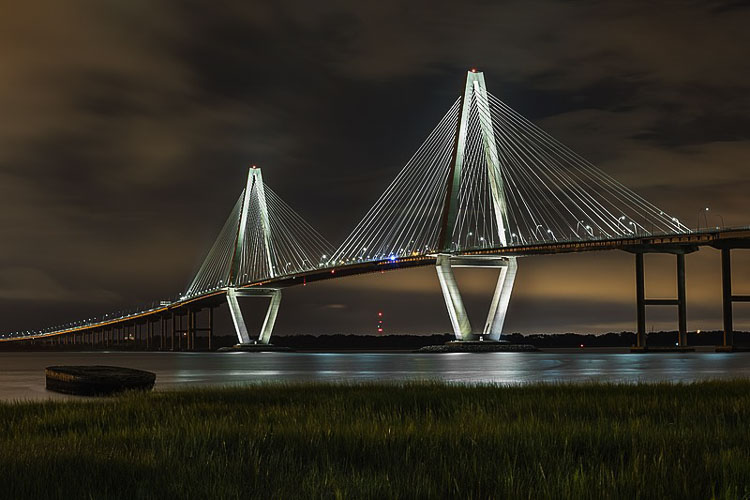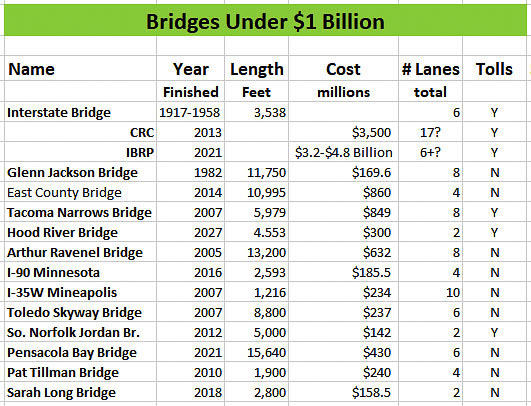CRC bridge was $792 million – under one quarter of $3.5 billion project
Please see editor’s note at bottom of story.
The failed Columbia River Crossing (CRC) was a $3.5 billion project. Forensic accountant Tiffany Couch revealed the actual bridge cost $792 million. Less than one quarter of the cost was for the actual bridge. The current Interstate Bridge Replacement Program (IBRP) expects if the same project was built, the cost could run anywhere from $3.2 billion to $4.8 billion.
The Interstate Bridge is actually two structures, one built in 1917 and the other built in 1958. Both are rated safe by ODOT and WSDOT, yet they do not meet current federal standards for freeways.
The bridge is 3,538 feet long, with its longest span being 531 feet. It provides 72 feet of clearance above the water at the highest point, and 176 feet when the bridge is open.
Part of the CRC’s demise was it’s size. One news report shared the following regarding the impact on Hayden Island. “The CRC plans one of its largest, most expensive and controversial sections across the island’s midsection. The existing freeway is being replaced by a 17-lane behemoth that will stand up to 45-feet high and 450-feet-wide.”
Other failures were the addition of light rail that Clark County did not want, the need for tolls to pay for borrowed money, and the fact the project delivered only a one minute improvement in the morning commute.
Simply put, spending $3.5 billion dollars, plus $2,000 per year in tolls for Clark County residents for a one minute savings in commute time was deemed a bad value. Legislators balked.
The current justification for replacing the bridge is its risk to a Cascadia Subduction Zone seismic event. The IBRP reports a seismic upgrade is too costly and complicated. The bridge therefore must be replaced they say.
What does a bridge cost? Can a bridge be built across the Columbia River for $1 billion or less?
In the aftermath of the CRC failure, Figg Engineering offered in 2014 to build a bridge east of I-205 for under $860 million. The structure would be 10,995 feet long and provide 144 feet of river clearance, matching the height of the I-205 Glenn Jackson Bridge.
The Tacoma Narrows Bridge is in reality two separate bridges, like the Interstate Bridge. The second bridge was constructed in 2007 to address growing traffic demand. It is 5,979 feet long, provides 187.5 feet of clearance below for marine traffic and has eight total lanes.
The new four-lane bridge cost $849 million, part of which was financed with tolls. It carries over 90,000 vehicles a day according to WSDOT. Some of that money went to upgrade the older bridge as well.
The Hood River Bridge across the Columbia River is about to be replaced. It will cost $300 million, have 2 lanes for traffic, one shared bike/pedestrian lane, and is 4,553 feet long. It will have tolls.
The Arthur Ravenel Bridge in Charleston, South Carolina was completed in 2005. WSP USA acted as the primary consultant on that project. IBRP Administrator Greg Johnson came from WSP. WSP has since been hired as the primary consultant for the Interstate Bridge project. (See Editor’s note below story.)
The Charleston bridge is 13,200 feet long, has eight lanes for vehicles, and provides 186 feet of clearance for marine traffic. It was designed to handle 100,000 vehicles each day and includes separate bike and pedestrian facilities. The total cost was $632 million and was finished one year early.
Tolling was discussed but rejected as a means of funding. “We’re not big on tolls,” said Billy Swails, former Mayor of Mt. Pleasant, S.C.

I-90 Mississippi River Bridge in Minnesota was completed in 2016 at a cost of $185.5 million. It is 2,593 feet long and has four lanes, two in each direction. No tolls were used to pay for the construction. Known as the New Dresbach Bridge, it is designed to accommodate a future pedestrian bridge suspended beneath and between the eastbound and westbound structures.
The Minneapolis I-35W bridge is more famous, having collapsed in 2007 due to a design flaw. The Saint Anthony Falls Bridge is 1,216 feet long and was built in 11 months. It has 10 lanes for traffic, provides 70 feet of clearance for marine traffic, and cost $234 million. It carried an estimated 141,000 vehicles daily in 2004 and has no tolls.
The Veterans’ Glass City Skyway, commonly called the Toledo Skyway Bridge, is a cable-stayed bridge on Interstate 280 in Toledo, Ohio. It is 8,800 feet long, offers 130 feet of clearance below for marine traffic, and has six lanes for vehicle traffic. The $237 million bridge was completed in 2007. It was the most expensive project ever undertaken by the Ohio DOT.
The South Norfolk (VA) Jordan Bridge is about 5,000 feet long, offers 145 feet of height for marine traffic and was built completely with private funds. It is part of a state highway and was completed in 2012. Total cost for the 2-lane bridge was $142 million and was privately funded. Presently, $2.65 tolls are paid via EZ Pass to the bridge owners.
The Pensacola Bay Bridge is currently being replaced. It will have six lanes for traffic plus multi-use lanes on each side for pedestrians and bikes, and 65 feet of clearance for marine traffic. The cost is estimated to be $430 million and will not include tolls. It is known as the “3-mile bridge,” for its 15,640 foot length.
The Mike O’Callaghan–Pat Tillman Memorial Bridge is an arch bridge that spans the Colorado River between the states of Arizona and Nevada near the Hoover Dam. It has four lanes of traffic, is 1,900 feet long, and is 890 feet above the water. It was completed in 2010 for $240 million and has no tolls.
The new Sarah Mildred Long Bridge carries the US Route 1 Bypass and a heavy rail line that serves the Portsmouth Naval Shipyard over the Piscataqua River. Coined “three bridges in one,” the crossing consists of vehicular approach bridges stacked over railroad approach bridges leading to a vertical lift span over the navigation channel.
It is 2,800 feet long, only has two lanes for vehicles, but also has a train track below for rail service, and the lift span. The $158.5 million project opened to traffic in March 2018.
What do all these bridges have in common? They cost less than $1 billion to construct. They are all over bodies of water.
Oregon has identified the need to spend $5.1 billion doing seismic upgrades on nearly 1,000 bridges and highways around the state. Seattle is doing extensive repairs to the West Seattle Bridge. It ultimately may need to be replaced. Other transportation needs around the region demand scarce transportation dollars as well.
The Clark County Council has asked to begin planning for a third and fourth bridge and transportation corridors across the Columbia River as part of the IBRP effort. They want a focus on improving traffic congestion, which means new transportation corridors and infrastructure.
Citizens want to save time in their travels, and get value for their transportation dollars.

Editor’s note:
This story has been edited from its original version, which stated: IBRP Administrator Greg Johnson came from WSP, and has hired WSP as the primary consultant for the Interstate Bridge project.
This statement from Frank Green, assistant program administrator, Interstate Bridge Replacement (IBR) program, refutes what was originally stated in Clark County Today’s story: “The process to select the consultant included an evaluation and selection panel consisting of ODOT and WSDOT that also received feedback from program partners. Program Administrator Greg Johnson was specifically excluded from any involvement in the evaluation and selection process to avoid any potential conflict of interest, and he did not have any involvement in the efforts to put together a team to compete for the work during his time at WSP. Proposals for the General Engineering Consultant were due on June 18, 2020, and interviews were held on July 6th, 2020, which was Program Administrator Johnson’s first day on the program that was spent onboarding at ODOT. Documentation of the submittal and selection process is public on the WSDOT Contracting Webpage: https://wsdot.wa.gov/business/consulting/ads/2020-interstate-bridge-replacement-program.”





In the case of the Hood River Bridge, the numbers in this article are outdated. It’s likely closer to the $400-450M range. Only 5% design has been conducted as NEPA nears an end. Still, though, under $1B.
Thanks, Kevin!
I thought it originally started at $250 million, and bumped up to $300 million in one document I found.
This is kind of like the I-5 Rose Quarter project. Originally it was budgeted for $450 million. Then it jumped to $795 million. Now it’s between $1.25 billion and $1.4 billion, and they haven’t even turned a shovel of dirt.
Government mismanagement here in Oregon and Washington are sadly wasting hundreds of millions of precious taxpayer dollars.
Great information John Ley!
Sense! Making sense, in a non-sense world, might be considered blasphemy in today’s left-wingnut world.
– BTW the Charleston bridge is a glorious example of engineering art. I want THAT bridge over our Columbia crossing.
Maybe you forget there are a couple of airports next to the river, so any bridge has to be not in their way.
Who’s the wingnut?
Im old enough to remember when planes flew up in the air, over tall buildings and bridges. … And planes had pilots who could easily steer the plane. . . . Its a radical concept that may escape some people.
NO Its Federal law. FAA regulations. The current bridge violates those airspace regulations for Pearson field, but the bridge was there first.
And the replacement bridge is grandfathered in.
Thank you again, John Ley, for writing such an informative news story! The video is helpful too in how it shows many impressive bridges around the country that were built for far less than what is being asked for a replacement to the I-5 bridge. I liked how you mentioned whether they had tolling or not, too. This all does bring up some very important questions. Please keep covering stories on the subject of the Interstate Bridge. It means a lot to have your strong voice speaking up for common sense and fairness.
The cute little table above needs another column indicating what level seismic event each bridge can withstand. Cutting travel time is one thing, surviving a seismic event (especially if you or a loved one is on the bridge at the time) is another.
Headshot —
The “challenge” you put out is that the majority of those bridges on the “table” were NOT in a seismic risk zone. Only the Hood RIver Bridge, the Tacoma Narrows Bridge, and the Interstate Bridge are in significant seismic risk zones. And the Hood River area has much less “risk” than the Portland and Tacoma areas.
Here is an article on seismic issues related to transportation in Oregon and Washington.
https://www.clarkcountytoday.com/news/5-1-billion-to-repair-replace-all-seismically-vulnerable-bridges-in-oregon-vs-up-to-5-billion-for-interstate-bridge/
I welcome your feedback and input.
The Ravenel bridge (Charleston) is subject to significant seismic risks and was designed accordingly.
Roadways and bridges are the lifeblood of our economy. The CRC didn’t focus on freight, or service vehicles as much as pedestrians and light rail for a few, estimated to be 1-3% of commuters. Even though Clark County voters rejected gold plated light rail twice, under the old CRC failed plain, an entire deck of a double decker bridge too low was dedicated to light rail, pedestrians, and bicycles, inflating the cost of the project. Light rail doesn’t carry any freight like shared roadways do, yet the cost to add light rail inflated the project tremendously. For freight especially, we need new corridors. Trucks going to the ports to pick up goods, then turning around to go back to a congested I-5 to deliver products on the west-side isn’t efficient in time or $. We need the port to port connections in a new westside corridor.
I think it’s important for people to understand exactly what “functionally obsolete” means when applied to highways and bridges. Somewhere in the bureaucracy of the Federal government, engineers decide the specifications of “Federally supported” highways. These specifications require certain lane widths and generous (paved) shoulder areas. Slightly different standards apply to
“ordinary” roads and “freeways.”
Essentially, the Interstate bridge is “functionally obsolete” because there are no shoulders. (This was a problem for the Richmond-San Rafael bridge in California, opened in 1958 with 3 lanes each way (on separate decks). The “solution” was to “re-stripe” the bridge making 2 lanes and shoulders on each deck. (Of course, this reduced total capacity and added traffic congestion, but it complied with the rules. Note that there was no change to the number of accidents occurring on the bridge — it has dedicated tow trucks stationed at each end of the bridge to respond to stalls, etc.) These rules are also quite visible in Texas — where there are numerous state-supported (only) highways striped as 4 lanes (no shoulder, no center barrier), while “US route” roads (of approximately the same pavement width) are simply 2 lanes with broad paved shoulders.
So, the Interstate Bridge met specifications in place as recently as the late 1950s (the time the second span was built) but no longer are “in spec” since the requirements have changed. Regular commuters may wish to consider how often delays are caused by stalls on the bridge vs. the increased congestion of re-striping the bridge to 2 lanes + shoulder so it would no longer be “functionally obsolete.
So long as Oregon/Portland are not interested in making improvements to freeways transversing Portland, “improvements” to the Interstate Bridge are actually pointless. While there are a number of stupid traffic engineering issues (e.g. northbound, on-ramp from Marine Drive, etc.) that create congestion, the real problems are simply due to the lack of capacity on I-5 further south.
The “real” solution is a return to the designs produced in the 1970s that gave us I-205 and had a proposal for a “western loop”, with bridge west of the Interstate Bridge and freeway passing near Tualatin and connecting back to I-5 near Wilsonville. Though, population growth since the original design might suggest a loop even further west, perhaps via Hillsboro and Newberg connecting back to I-5 in or near Salem. Such a route would draw through traffic away from Portland’s center with its considerable congestion (and lack of political will to make improvements).
Pete —
Excellent added information and details. Thank you!